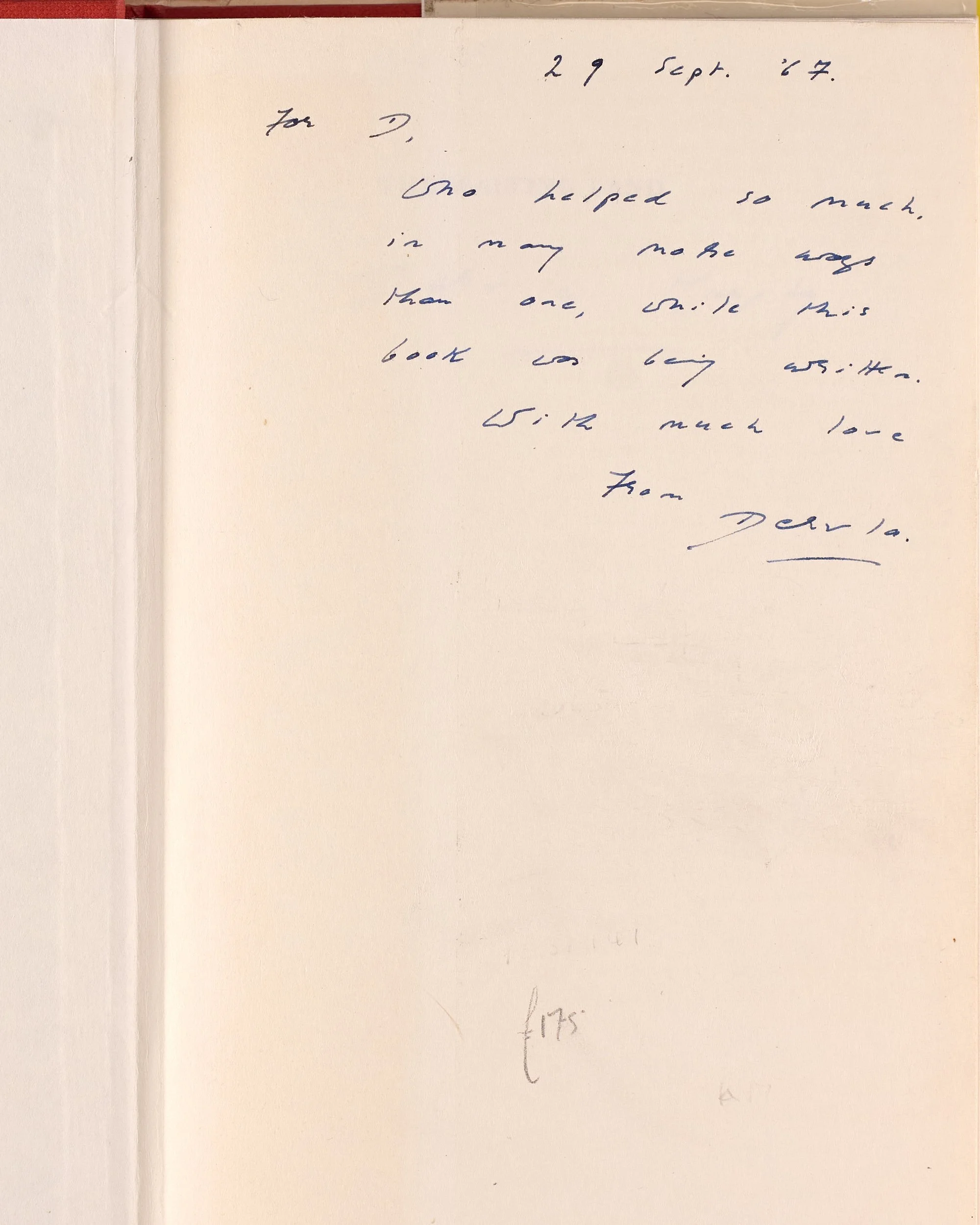 Image 1 of 2
Image 1 of 2

 Image 2 of 2
Image 2 of 2



The Waiting Land. A Spell in Nepal
MURPHY, Dervla
The Waiting Land. A Spell in Nepal
London: John Murray, 1967
8vo., red publisher’s boards, backstrip lettered in gilt with wheel device to head of spine; together in the unclipped pictorial dustwrapper (30s net) with a jacket design by Craig Dodd, and featuring a photograph by Ewan MacLeod to the upper panel; pp. [vi], vii-ix, [i], 216, [ii]; with 16 captioned black and white photographs, as well as a double page map showing central Nepal to p. 14/15; marginal offsetting to endleaves; a touch bruised to spine tips; else essentially a fine copy in the ever-so-slightly toned and creased near-fine dustwrapper.
First edition, presumably the dedication copy, inscribed by the author to the ffep: “For D, / Who helped so much, / in many more ways / than one, while this / book was being written. / With much love / from Dervla.” and dated in the year of publication, 29th September ‘67. Murphy has additionally signed her name beneath the half title. The inscription is presumably the ‘Daphne’ mentioned in the dedication, to whom Murphy wrote a series of letters home during the 1960s, and the contents of which later became her working notes for ‘The Waiting Land’.
It was in January 1963 that Murphy fulfilled a lifelong dream of cycling from the UK to India. Immortalised in her celebrated 1965 book Full Tilt, the trip was followed, in 1965, by a six month stint in Nepal, with both The Waiting Land and Tibetan Foothold written predominantly by candlelight. The present work follows her journey from Kathmandu, through the Pokhara Valley and into the remote Langtang region, which borders Tibet, though much of the book describes her work in Pardi, where she volunteered at a refugee camp.
The third of Murphy’s early travel books, and undoubtedly one of the best works written on the subject of the Himalayas, from the perspective of a pioneering female travel writer who lived and worked amongst the mountain people. “Nepal weaves a net out of splendour and pettiness, squalor and colour, wisdom and innocence, tranquility and gaiety, complacence and discontent, indolence and energy, generosity and cunning, freedom and bondage”, she writes, “in this bewildering mesh foreign hearts are trapped, often to their own dismay”.
MURPHY, Dervla
The Waiting Land. A Spell in Nepal
London: John Murray, 1967
8vo., red publisher’s boards, backstrip lettered in gilt with wheel device to head of spine; together in the unclipped pictorial dustwrapper (30s net) with a jacket design by Craig Dodd, and featuring a photograph by Ewan MacLeod to the upper panel; pp. [vi], vii-ix, [i], 216, [ii]; with 16 captioned black and white photographs, as well as a double page map showing central Nepal to p. 14/15; marginal offsetting to endleaves; a touch bruised to spine tips; else essentially a fine copy in the ever-so-slightly toned and creased near-fine dustwrapper.
First edition, presumably the dedication copy, inscribed by the author to the ffep: “For D, / Who helped so much, / in many more ways / than one, while this / book was being written. / With much love / from Dervla.” and dated in the year of publication, 29th September ‘67. Murphy has additionally signed her name beneath the half title. The inscription is presumably the ‘Daphne’ mentioned in the dedication, to whom Murphy wrote a series of letters home during the 1960s, and the contents of which later became her working notes for ‘The Waiting Land’.
It was in January 1963 that Murphy fulfilled a lifelong dream of cycling from the UK to India. Immortalised in her celebrated 1965 book Full Tilt, the trip was followed, in 1965, by a six month stint in Nepal, with both The Waiting Land and Tibetan Foothold written predominantly by candlelight. The present work follows her journey from Kathmandu, through the Pokhara Valley and into the remote Langtang region, which borders Tibet, though much of the book describes her work in Pardi, where she volunteered at a refugee camp.
The third of Murphy’s early travel books, and undoubtedly one of the best works written on the subject of the Himalayas, from the perspective of a pioneering female travel writer who lived and worked amongst the mountain people. “Nepal weaves a net out of splendour and pettiness, squalor and colour, wisdom and innocence, tranquility and gaiety, complacence and discontent, indolence and energy, generosity and cunning, freedom and bondage”, she writes, “in this bewildering mesh foreign hearts are trapped, often to their own dismay”.

